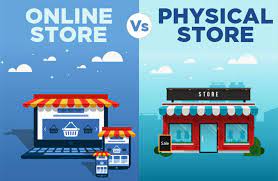What if running an online store wasn’t all that different to running a physical store? If you look at online stores vs physical stores, is there really that much difference?
Sure, online stores don’t have quite the same overheads as a physical store (hosting fees are almost always cheaper than rent). There’s also no face-to-face interaction involved when selling online. However, aside from these differences, many of the same rules and tactics apply to both online and physical retail.
Below are just a few ways in which the rules of a physical store can be applied to an online store – and vice versa.
If you want to attract customers into a physical store and get them to buy your products, you need to create an eye-catching shop front and you need to create striking product displays. Similarly, when building a website that generates customers, it’s important to have an eye-catching homepage and striking product photographs.
A website that is too plain and simple won’t grab visitors the same way that a dull shopfront won’t encourage footfall. Large images on a homepage are as essential as a vibrant window display. Bold call-to-action buttons on a website can meanwhile have the same impact as salient signage.
In both cases, it’s important to not let your store’s appearance become stale or outdated. Just like tired decor in a store, old-fashioned web design can make your website feel less professional. Meanwhile, if you’re not making regular updates to your physical store or website, it’s unlikely you’ll get return customers as they won’t have anything new worth returning for.
Just as you would invest money into interior design in a store, it pays to invest money into web design when building a company website. With a professional eye for design, you can ensure that your store looks fresh and exciting. On top of this, it’s worth paying for professional product photographs to help showcase your products in the best light (professional product photos can also come in use in physical retail if you want to build posters or billboards related to deals).
In a physical store, customers can pick up a product and get a good idea of what they’re buying before they purchase it. Clothes can be tried on, perfumes can be smelt and in some cases food can be tasted. Physical shop owners can play to all the senses – making shopping more of an ‘experience’.
This is a level of interaction that cannot be replicated when shopping online. However, there are still ways in which you can allow customers to interact with online products to help give it that ‘experience’ feel. For instance, when providing photographs of products, you could use 3D photos that allow customers to look at a product from all angles. On top of this, there’s also the option of adding demo videos of products to give customers a better idea of them. You can even use sound clips if you’re selling a product such as a musical instrument.
Several elements of the digital experience have started to transfer over into physical stores. A growing number of stores have started to use digital touchscreen catalogues and video advertisement boards to provide a new level of interaction that static visuals cannot provide.
AR (augmented reality) technology is thought to be the next big evolution in interactive retail. This could be something that we see in both online stores and physical stores – using an app, it may be possible to try on clothes virtually or see how a sofa may look in our living room. Start planning for the future by considering ways in which you may be able to embrace this technology.
Source : https://www.mikegingerich.com/blog/online-stores-vs-physical-stores-are-they-that-different/








